The news that doesn't make the news...
Saturday, January 31, 2009
In corporate media there is something know as "the buying mood." It essentially refers to news media's creation of a state that inspires readers, listeners, and viewers to buy products. It's unsurprising that such a thing exists, considering that 80% of revenues for newspapers come from ads (James Winter, Lies the Media Tells Us). Newspapers, thus, walk the line between working for corporations and providing the public with fair and objective news. Television news stations also negotiate the line between reeling in viewers for their corporate sponsers and disseminating the news. Even the CBC, formerly publicly funded, is turning towards more private sponsorship.
One of the stipulations of "the buying mood" is that the content of the news shouldn't overshadow the products for sale on the next page or in the upcoming commercials. For example, in 1996 Chysler Corporation's ad agency, PentaCom, sent out a contract to 50 magazines with the following clause:
"In an effort to avoid potential conflicts, it is required that Chrysler Corporation be alerted in advance of any and all editorial content that encompasses sexual, political, social issues or any editorial that might be construed as provactive or offensive."Essentially, that means if your magazine plans on running anything Chrysler doesn't agree with, they'll pull their ads and their money. Now, I don't necessarily blame Chrysler for this, that's their business perogative, nor do I blame magazines who go along with it, because that is their's. But we are fools if we think that news media can provide objective and hard-hitting news while at the same time pandering to their corporate sponsors.
According to Sut Jhally, commercials work by issuing an emotional appeal to potential buyers. Hence, it makes sense that corporations would want to limit the amount of emotional appeal news content has, so that ads can stand out by comparison. Of course, there are many other reasons why our corporate news stays relatively unemotional, but we'll talk about those in later posts.
This brings me to the real point of this post: Israel and Gaza. I have noticed that whenever I turn on the TV, I get the same non-specific turns of phrase, the same pictures, the same neatly processed and cleaned up stories. "The buying mood," makes it impossible to show any images that actually capture the intense conflict going on.
The following images are very difficult to look at. But I think they are very important pictures to look at because they represent the truth of what's going on in Israel and Gaza. You won't see them on the evening news. They have been collected and captioned by The Big Picture.
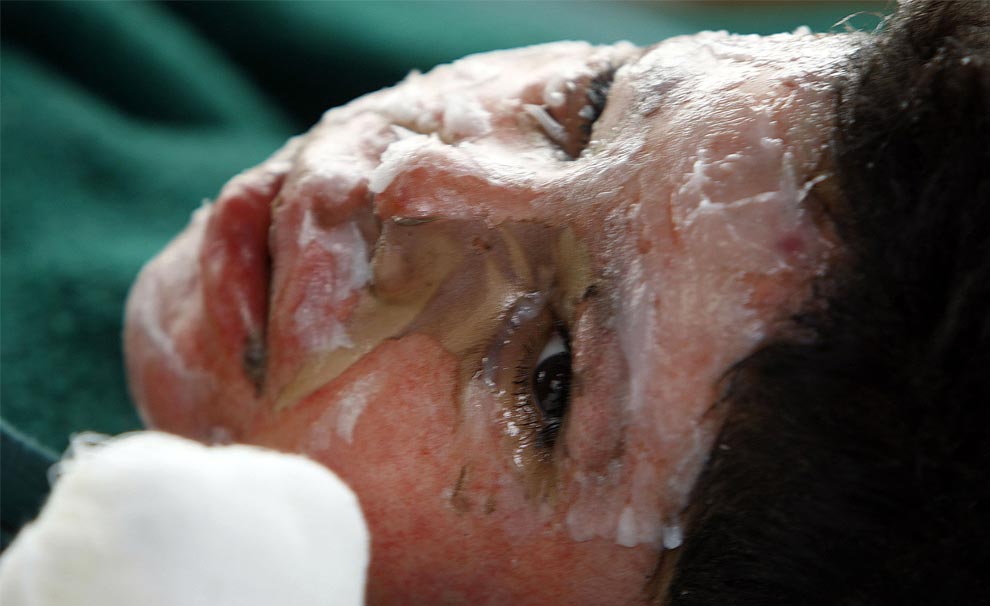 Mahmoud Tark, an nine-year-old injured Palestinian boy, is transported by Red Crescent officials on an ambulance at the Rafah border crossing between Egypt and the Gaza Strip to a hospital in Al-Arish December 30, 2008. Palestinians wounded in the Israeli attack on Gaza trickled into Egypt on Monday after a day and a half of confusion and disagreement between the Hamas and the Egyptian government. (REUTERS/Amr Dalsh (EGYPT)
Mahmoud Tark, an nine-year-old injured Palestinian boy, is transported by Red Crescent officials on an ambulance at the Rafah border crossing between Egypt and the Gaza Strip to a hospital in Al-Arish December 30, 2008. Palestinians wounded in the Israeli attack on Gaza trickled into Egypt on Monday after a day and a half of confusion and disagreement between the Hamas and the Egyptian government. (REUTERS/Amr Dalsh (EGYPT)  Samera Baalusha (34) (right) sits with her daughter Eman (15) and surviving son Mohamad (15 months) while waiting to see the body of her 4-year-old daughter Jawaher Baalusha during the funeral held for Jawher and her four other sisters who were all killed in an Israeli missile strike, on December 29, 2008 in the Jebaliya refugee camp, in the northern Gaza Strip. Jawher Baalusha and her sisters were killed during an Israeli air raid while they were sleeping together in their bedroom. Medics stated that the raid had targeted a mosque near their home in Jabalia. (Abid Katib/Getty Images)
Samera Baalusha (34) (right) sits with her daughter Eman (15) and surviving son Mohamad (15 months) while waiting to see the body of her 4-year-old daughter Jawaher Baalusha during the funeral held for Jawher and her four other sisters who were all killed in an Israeli missile strike, on December 29, 2008 in the Jebaliya refugee camp, in the northern Gaza Strip. Jawher Baalusha and her sisters were killed during an Israeli air raid while they were sleeping together in their bedroom. Medics stated that the raid had targeted a mosque near their home in Jabalia. (Abid Katib/Getty Images)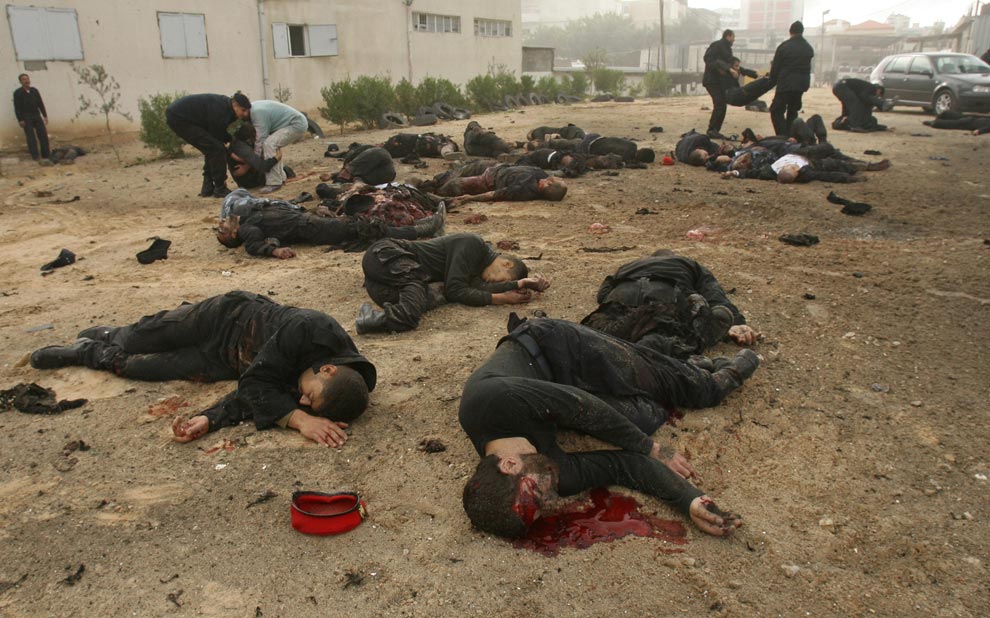 Many bodies lie outside the Hamas police headquarters following an Israeli air strike in Gaza City on December 27, 2008. (MOHAMMED ABED/AFP/Getty Images)
Many bodies lie outside the Hamas police headquarters following an Israeli air strike in Gaza City on December 27, 2008. (MOHAMMED ABED/AFP/Getty Images)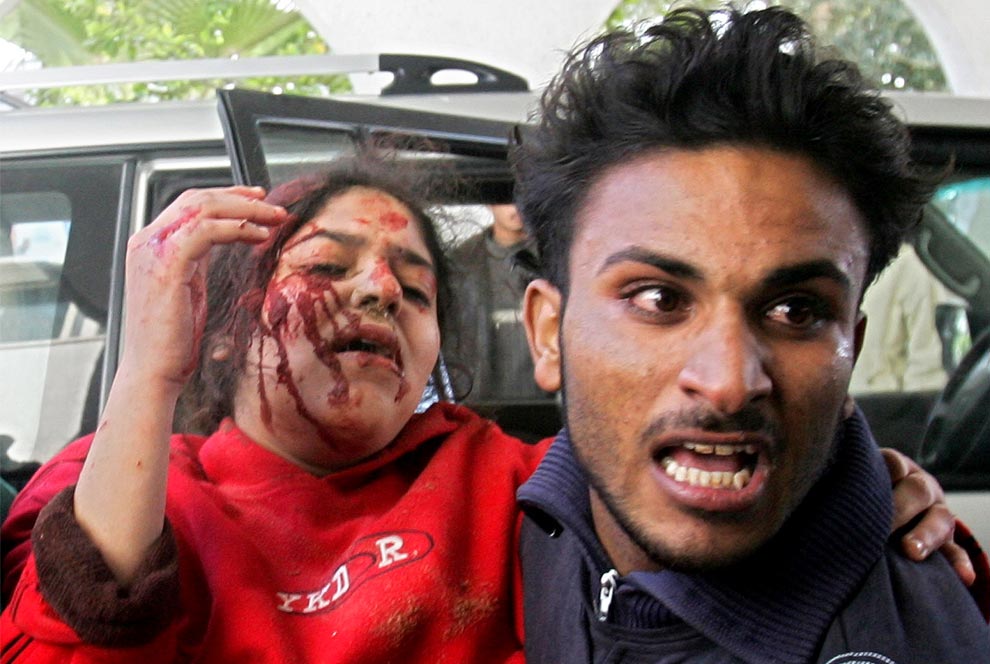 A wounded Palestinian girl is carried into the Al-Shifa hospital on December 28, 2008 in Gaza City, Gaza. (Abid Katib/Getty Images)
A wounded Palestinian girl is carried into the Al-Shifa hospital on December 28, 2008 in Gaza City, Gaza. (Abid Katib/Getty Images)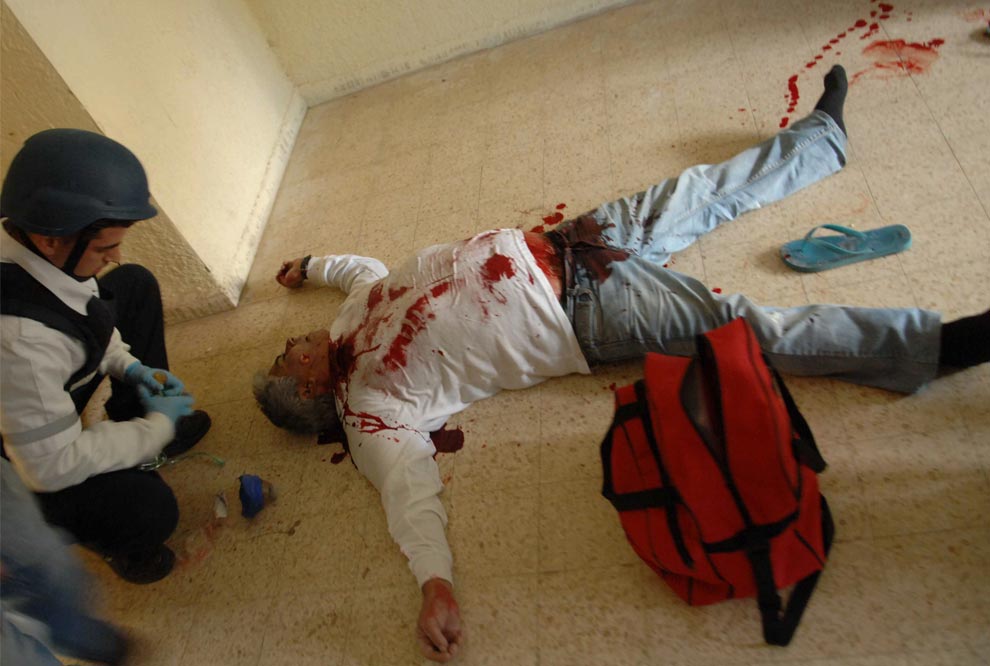 A medic crouches over the body of an Israeli man after he was killed in a rocket attack launched from the Gaza Strip and hit the southern Israeli town of Netivot on December 27, 2008 following Israeli bombardment on the Palestinian costal strip. The rocket attack killed one man and wounded four others, according to the Magen David Adom, Israel's equivalent of the Red Cross. (HAIM HORENSTEIN/AFP/Getty Images)
A medic crouches over the body of an Israeli man after he was killed in a rocket attack launched from the Gaza Strip and hit the southern Israeli town of Netivot on December 27, 2008 following Israeli bombardment on the Palestinian costal strip. The rocket attack killed one man and wounded four others, according to the Magen David Adom, Israel's equivalent of the Red Cross. (HAIM HORENSTEIN/AFP/Getty Images)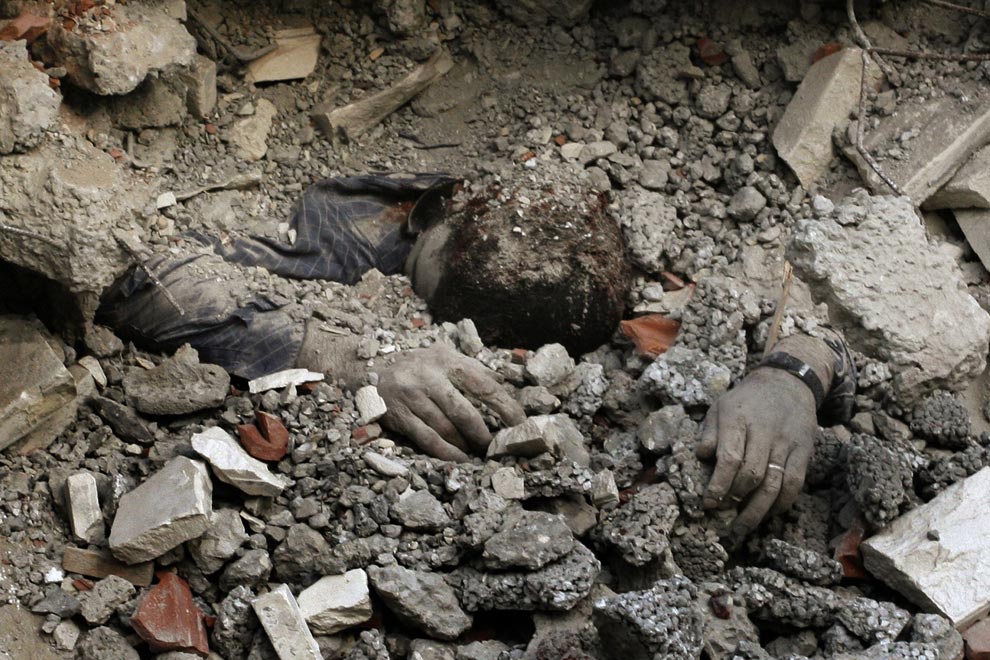 The body of a Palestinian security force officer lays in the rubble after an Israeli missile strike on a building in Gaza City, Sunday, Dec. 28, 2008. (AP Photo/Fadi Adwan)
The body of a Palestinian security force officer lays in the rubble after an Israeli missile strike on a building in Gaza City, Sunday, Dec. 28, 2008. (AP Photo/Fadi Adwan) A wounded child awaits medical attention at the Shifa hospital on December 27, 2008 in Gaza City, Gaza. (Abid Katib/Getty Images)
A wounded child awaits medical attention at the Shifa hospital on December 27, 2008 in Gaza City, Gaza. (Abid Katib/Getty Images)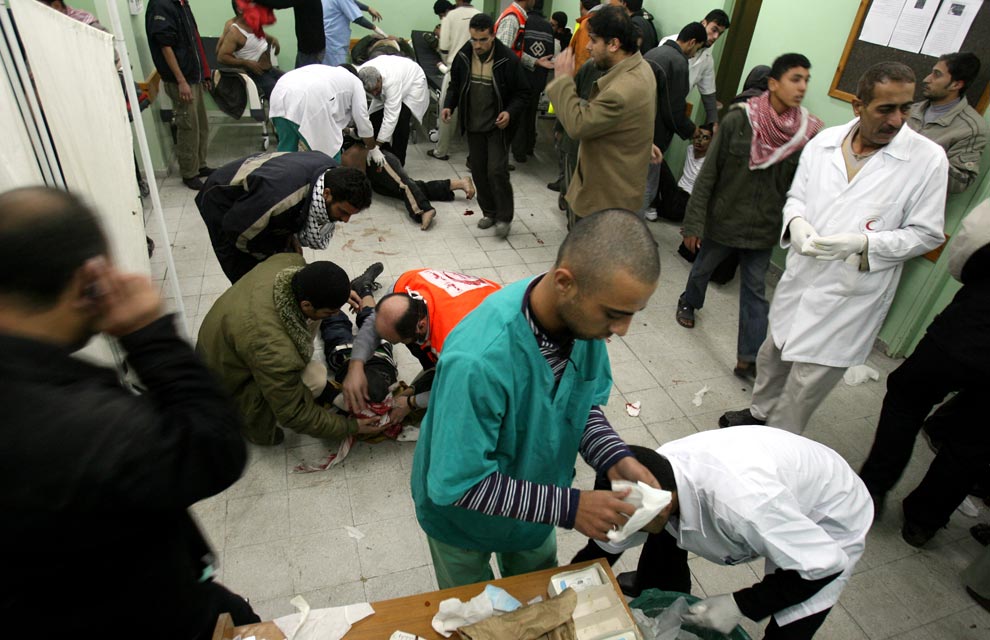 Wounded Palestinians are treated on the floor of crowded Kamal Edwan hospital in Beit Lahia in the northern Gaza Strip on December 29, 2008, following an Israeli air strike on the nearby Jabalia refugee camp. Israeli tanks massed at the Gaza border today as warplanes continued pounding Hamas targets in the densely populated enclave. (MOHAMMED ABED/AFP/Getty Images)
Wounded Palestinians are treated on the floor of crowded Kamal Edwan hospital in Beit Lahia in the northern Gaza Strip on December 29, 2008, following an Israeli air strike on the nearby Jabalia refugee camp. Israeli tanks massed at the Gaza border today as warplanes continued pounding Hamas targets in the densely populated enclave. (MOHAMMED ABED/AFP/Getty Images)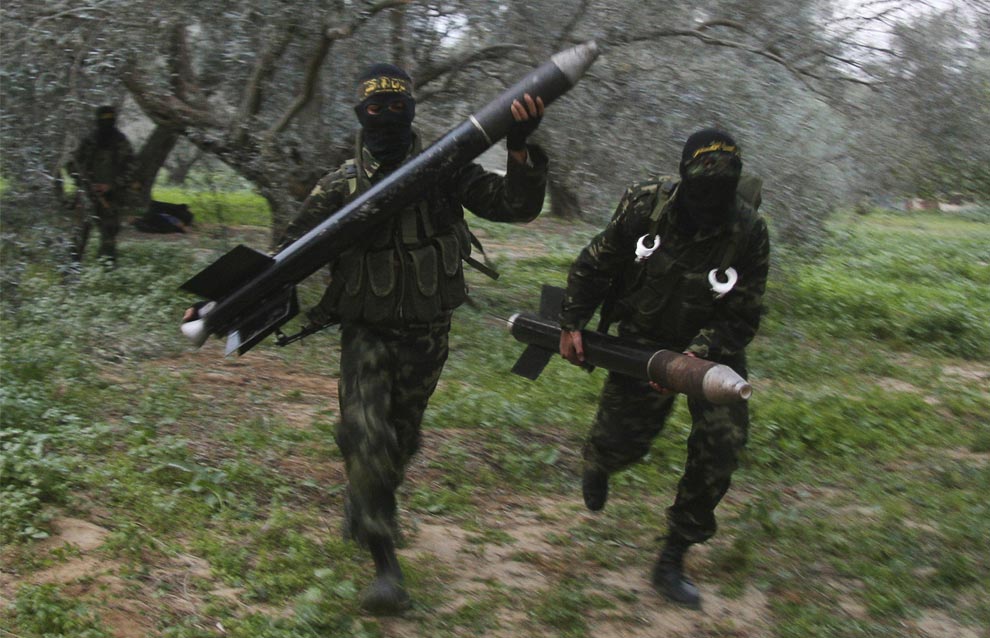 Masked Palestinian militants from Islamic Jihad run with homemade rockets to put in place before later firing them into Israel on the outskirts of Gaza City, Saturday, Dec. 20, 2008. (AP Photo/Ashraf Amra)
Masked Palestinian militants from Islamic Jihad run with homemade rockets to put in place before later firing them into Israel on the outskirts of Gaza City, Saturday, Dec. 20, 2008. (AP Photo/Ashraf Amra) Palestinian firefighters try to extinguish flames at a medical warehouse after an Israeli airstrike targeted at a fuel tank nearby in the southern Gaza Strip town of Rafah on Sunday, Dec. 28, 2008. Israel widened its deadliest-ever air offensive against Gaza's Hamas rulers Sunday, pounding Hamas targets, smugglers' tunnels and a central prison. (AP Photo/Xinhua)
Palestinian firefighters try to extinguish flames at a medical warehouse after an Israeli airstrike targeted at a fuel tank nearby in the southern Gaza Strip town of Rafah on Sunday, Dec. 28, 2008. Israel widened its deadliest-ever air offensive against Gaza's Hamas rulers Sunday, pounding Hamas targets, smugglers' tunnels and a central prison. (AP Photo/Xinhua) An Israeli police officer kneels over a dog that was badly injured after a rocket landed in the southern town of Sderot, Israel on December 30, 2008. (GIL COHEN MAGEN/Reuters)
An Israeli police officer kneels over a dog that was badly injured after a rocket landed in the southern town of Sderot, Israel on December 30, 2008. (GIL COHEN MAGEN/Reuters)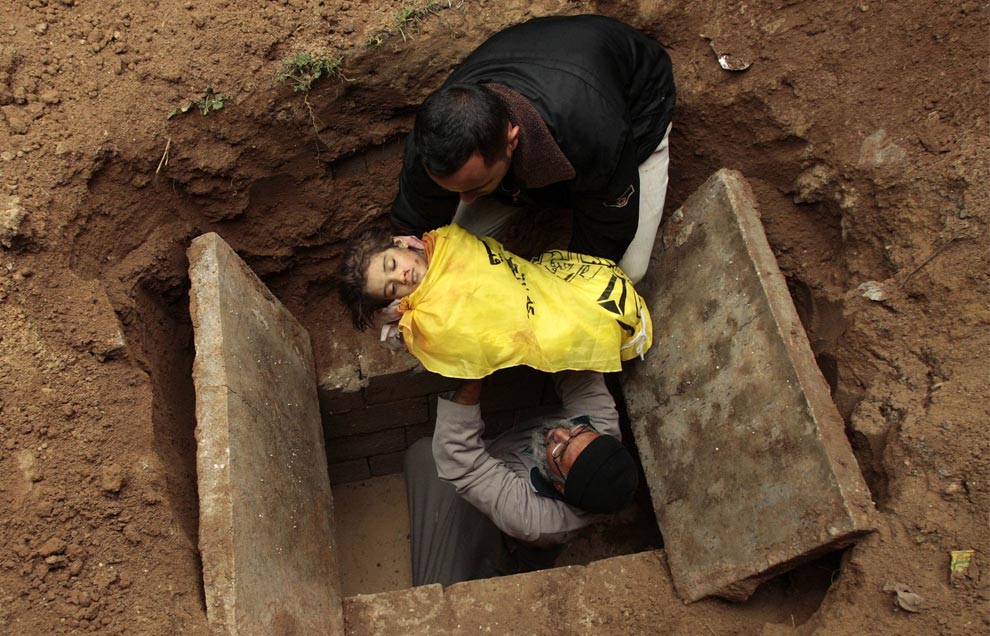 Palestinian men bury the body of 4-year-old Lama Hamdan at Beit Hanoun cemetery in the northern Gaza Strip December 30, 2008. Lama and her sister were reportedly riding a donkey cart Tuesday near a rocket-launching site that was targeted by Israel. (MOHAMMED SALEM/Reuters)
Palestinian men bury the body of 4-year-old Lama Hamdan at Beit Hanoun cemetery in the northern Gaza Strip December 30, 2008. Lama and her sister were reportedly riding a donkey cart Tuesday near a rocket-launching site that was targeted by Israel. (MOHAMMED SALEM/Reuters)My point in posting these images is to remind us that what we see when we sit down in front of the television at night isn't what's going on. TV news isn't the news.
Here's an interesting story. The BBC recently refused to air a video (available here) created by the Disasters Emergency Commitee, DEC, about the need for humanitarian aid in Gaza. The clip opens by stating that it is not about the rights and wrongs of the conflict, but rather about the fact that there are human beings and children in Gaza who are in desperate need of aid. Mark Thompson, the BBC Director General (who in 2005 travelled to Israel to hold a personal meeting with Ariel Sharon, and is reported as having "a far greater regard for the Israeli cause than some of his predecessors"), stated: "We do want to cover the humanitarian story, we want to cover it in our news programmes where we can put it in context, we can do it in an even, carefully balanced, objective way. We worry about being seen to endorse something which could give people the impression that we were backing one side."
However, I think we get a better glimpse of the truth from Andy Burham, the cultural secretary, who said it was a difficult decision for the BBC "because of the way it is funded."
Is the BBC really fufilling the role as a provider of news by refusing to air very important information on how to donate to DEC? Are they really giving their viewers all the information? Who are they choosing: the public or their corporate sponsers? Are there, perhaps, some personal biases getting in the way of the news? Is the buying mood affecting what they choose to air? Again, it is their business perogative to do as they do, but it certainly doesn't make for what they claim they are trying to achieve: objectivity.
Now, the focus of this article has been more about media, and some limited reactions to one conflict, but I think the lack of images, the pick-and-choose stories, the dull stories given by professionally unemotive faces, say something really huge about corporate media. You've got to ask yourself: why I am I seeing what I'm seeing? Why not show the real pictures, why not tell me what really happened today, why not give me some information on humanitarian aid? Do I really want to get my news from people whose JOB IT IS to worried about a corporation's bottom line?
More information on Israel and Gaza (from some sources that are perhaps less biased) is available from many of the media links in the sidebar.
Hopefully, I'll blog in more depth on the topic at a later time, but I feel like this post is already starting to go in a few too many directs, so I'll stop here for now.
Labels: gaza, israel, media, the buying mood
posted by Ashley Girty @ 11:36 AM,
![]()
1 Comments:
- At February 28, 2009 at 1:45 PM, Miss X said...
-
This is one of the reasons that I have started my blog. I am trying to stay away from news channels such as CCN, ABC, NBC, etc that only show one side of the story or even worse show the news from the "buying mood" perspective. It really agrevates me as well when I turn on the the news and everything is glossy and clean leaving out the truth of what is really going on around there. They think that if they show those images (like the ones you have posted here) on television than people will get offended, but people tend to forget that THIS IS THE TRUTH! They are not trying to be valgur or rude, this isnt a "fake" movie, this is what is REALLY happening.
More importantly, the news leaves out a lot of important information. They place great emphasis on the idea that this conflict is something "new" and even worse is when they continue to base the story on myths.
Your more then welcome to check out my blog to learn more about the conflict!



Post a Comment